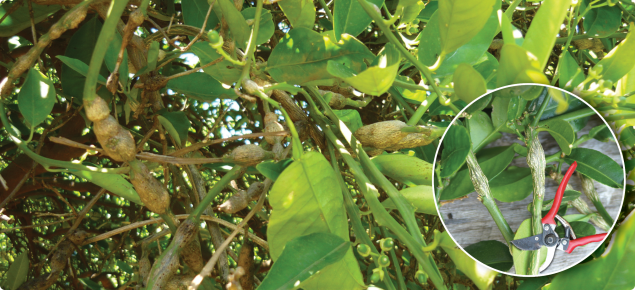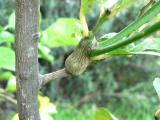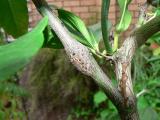Pest status in Western Australia
Citrus gall wasp (CGW) was first detected in WA in the Perth suburb of Eden Hill in 2013. It is now an established pest in the Perth metropolitan area. There is no legal requirement to control this pest in Western Australia, it should be managed like other established pests such as Mediterranean fruit fly, aphids and scales.
CGW has not yet been found in a commercial citrus orchard in WA. To help the industry keep track of the spread, please report CGW found in regional areas (outside of Perth) using the MyPestGuide® Reporter app or web tool.
Overview
Citrus gall wasp is an Australian native insect from northern NSW and Queensland. While its natural host is the Australian finger lime (Citrus australasica), all cultivated citrus varieties can be readily infested, though their susceptibility differs. For example:
- ‘Rough lemon’ and ‘Troyer citrange’ rootstocks are very susceptible.
- Grapefruit is the most susceptible cultivated variety.
- Lemons and oranges can be seriously affected.
Over time it has spread throughout the major citrus production regions of eastern Australia, such as the Riverina and Sunraysia where it is considered a serious pest. It has not yet been found in citrus production regions in WA.
CGW eggs are layed in new shoots of citrus trees in spring. The tree reacts by producing distinctive galls around the developing larvae (Figure 2).
How it spreads
Adults wasps have a limited flying range so the close presence of infested citrus trees is usually the cause of spread to backyard trees and orchards. Wasps can be spread over long distances by the wind and by movement of infested trees or untreated infested branches.
Pest description and lifecycle
CGW produces a single generation each year, spending 95% of its growth and development inside galls in branches (Figure 1). Understanding the lifecycle of these wasps will help inform what control option to use, and when.
Adult wasps emerge from galls in spring (September to December), when environmental conditions are suitable. Emergence is strongly associated with the spring growth flush. CGW are small (2.5mm), shiny black wasps, that live for 3 – 7 days, depending on temperature. Females can lay up to 100 eggs in this time. Egg laying starts immediately after wasps emerge with most laid within the first three days.
Eggs are concealed under the bark of new season citrus shoots. They are less than 0.5mm, oval shaped, white, and slightly opaque, hatching in 2-4 weeks.
Larvae then burrow into the bark for 9–10 months. Woody tissue forms around the larvae causing the distinctive swelling of the gall. By the following winter, the larvae inside the gall pupate ready to emerge again as adults in spring.
Damage
The galls produced around the developing larvae disrupt water and nutrient flow which can weaken trees and affect productivity. Heavy infestations will reduce fruit size and quantity over time.
What to look for
|
|
|
|
|
|
Management for home gardeners
Citrus gall wasp is now widespread in the Perth metropolitan area and will be an ongoing pest to manage in the garden. While CGW can be difficult to control, there are things that can be done to minimise the damage and prevent spread of this pest to new regions and commercial orchards. We recommend that you work with your neighbours to reduce the rate at which trees are reinfested each year, but regardless the pest will remain in the area.
The citrus industry is investing in research to identify new techniques for controlling this difficult to manage pest. As new control measures are identified, they will be added to this webpage.
The management calendar below provides a guide for monitoring and management of citrus gall wasp over the year. Timing of control actions varies with locations and timing will be earlier in warmer climates. Follow citrus tree development suited to your region.
Control methods
Pruning
Prune out new galls before winter (February to end of June) to avoid the need to treat galls before disposal. Pruned material can be kept at your property or go into green waste (bin or verge collection) or general rubbish. Larvae inside the galls will not survive at this time of year.
Wasps can emerge from galls in pruning offcuts if pruned too close to the usual emergence period, spreading the pest further around the State. To reduce the spread and reinfestation of your tree, galls removed from July to November should be treated before disposal. Treat galls by either:
- Solarising by placing them in a well-sealed plastic bag and left in the sun for at least four weeks. For bulk cuttings, galls can be securely covered with a tarp.
- Shredding/mulching
- Burning (if permitted) - check your local government guidelines and total fire bans.
Be aware that over-pruning your tree in winter will encourage lots of new growth which is more susceptible to citrus gall wasp. There is no need to remove old galls. Old galls will have tiny holes where the wasps have already emerged (Figure 4).
Fertiliser timing
Avoid heavily fertilising trees in winter or spring. Over-fertilising (particularly heavy nitrogen applications) can promote excessive amounts of spring growth that the gall wasp prefers, making trees more susceptible to infestations.
Chemical control
Chemical control in the home garden is problematic. Chemicals registered for gall wasp are only available in commercial quantities for use in commercial-sized orchards. There are no insecticides registered to kill adult citrus gall wasps. Available products target either the developing larvae in the galls or work to disrupt egg laying during the wasp emergence period in spring.
Always check the APVMA website and follow label instructions, witholding periods and permit conditions.
- Systemic soil-applied insecticides containing Imidacloprid or clothiandin are registered for the control of citrus gall wasp in commercial orchards. They are applied after flowering and control developing larvae before they form destructive galls.
- Calcined kaolin can be used as a barrier film to protect new growth from citrus gall wasp during spring when wasps emerge (September to November). The barrier acts a repellent and can disrupt egg laying if spring flush is adequately covered. Two or more applications may be required.
- Petroleum spray oils can deter gall wasp adults from laying eggs.
- For home gardeners, horticultural glue (a sticky non-drying glue made from natural gum resins, vegetable oil and wax) can be pasted over galls in early September to trap emerging wasps, preventing reinfestation.
Natural enemies
Megastigmus brevivalvus and M. trisulcus are two beneficial wasps present in WA. They lay their eggs directly into citrus gall wasp eggs, eventually killing the larvae. Unfortunately, they are not present in sufficient numbers to control citrus gall wasp.
More information for commercial growers
Citrus gall wasp in Southern Australia
Citrus gall wasp - IPDM Fact sheet
Report citrus pests - regional areas only
Use the MyPestGuide® Reporter app or web tool to report citrus gall wasp observed outside the Perth metropolitan area, especially in citrus growing regions. Make sure you include a photo of the pest and your location when making your report as this is important information for us to confirm the pest and track its spread.
 | MyPestGuide® Reporter |






